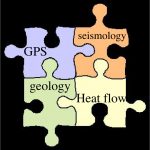Students, colleagues and I have been exploring a variety of issues related to the New Madrid seismic zone in the central US and similar regions of continental intraplate earthquakes. We are interested in understanding the underlying tectonics and also how to best characterize the earthquake hazard and formulate cost-effective policies to mitigate it.
Twenty years ago, about all we could say about the area was that small earthquakes occur today, and that large earthquakes had happened in the past and might happen again. Recent data, however, are coming together to give new insight. Taken together, the new data suggest that the New Madrid seismic zone may be shutting down after the recent cluster of large earthquakes in the past 1000 years. If so, it will be a very long time until the large earthquakes of 1811-12 recur.
This view comes from combining four key things that have been learned in the past 15 years:
1) Precise measurements with GPS show that the ground is barely moving or isn’t moving, so little or no strain is building up for a future earthquake
2) The small earthquakes we see today look like aftershocks of the large 1811-12 earthquakes
3) The New Madrid zone doesn’t look thermally or mechanically different from many other structures in the central U.S.
4) Geological data show that the New Madrid zone goes through pulses of activity
The simplest explanation is that the present pulse is ending
Public radio interview about this idea: mp3
More information about the geological data: pdf
One way to approach the issue is to ask a fundamental question about continental intraplate earthquakes: why they are where they are. For example, why are the New Madrid Seismic Zone (NMSZ) earthquakes concentrated on the Reelfoot Rift, when the continent contains many fossil structures that would seem equally likely candidates for concentrated seismicity? A key to answering this question is understanding the thermo-mechanical structure of the seismic zone. If it is hotter and thus weaker than surrounding regions, the weak lower crust and mantle concentrate stress and seismicity in the upper crust. Alternatively, if it is not significantly hotter and weaker than its surroundings, the seismicity is likely to be a transient phenomenon that migrates among many similar fossil weak zones. The two models have very different implications for seismic hazard policy.
Analysis of heat flow with J. McKenna (U.S. Army Engineer Research & Development Center) and C. Stein (University of Illinois, Chicago) shows (see map) that heat flow in the NMSZ is no higher than elswewhere in the central US. Hence there is no reason to assume that the NMSZ is significantly hotter and weaker than its surroundings. These results imply that the seismicity is likely to be a transient phenomenon that migrates among many similar fossil weak zones.
This issue is important for assessing the earthquake hazard in the central United States. Large earthquakes (magnitude 7) occurred in 1811 and 1812, causing shaking across much of the area. Houses collapsed in the tiny Mississippi river town of New Madrid, Mo., and minor damage occurred in St. Louis, Louisville and Nashville. The smaller earthquakes that continue in the area today are typically more of a nuisance than a catastrophe. The largest in the past century, the 1968 southern Illinois earthquake (magnitude 5.5), was widely felt and caused some damage but no fatalities. However, if large earthquakes like those of 1811-12 occurred again, they would be very destructive.
The new heat flow results fit into a growing idea that earthquakes can migrate among similar faults, some of which — such as the Meers fault in Oklahoma — appear to have been active about 1,000 years ago but show no activity today. Geological studies find that New Madrid earthquakes comparable to those of 1811-1812 occurred about 1450 and 900 AD. However, because this fault system has not generated significant topography, it is likely to have “turned on” relatively recently, perhaps within the past few thousand years.
In this view, prior earthquakes were concentrated on other faults, and future earthquakes will occur somewhere else when the New Madrid system “shuts down.” Once this happens, it may be a very long time — thousands of years or longer — before New Madrid becomes active again.
Migrating earthquakes also occur in the interior of other continents, like Australia. This is very different from the way earthquakes occur on boundaries between plates, like the San Andreas fault along the boundary between the Pacific and North American plates. Because the plates keep moving, earthquakes continue to occur on the boundaries in the same places.
Although we don’t know when the New Madrid fault system will shut down, the fact that precise measurements using the Global Positioning System – discussed on the next page – show that motion across the New Madrid Seismic Zone currently is either very slow or zero suggests that it may be dying today. If so, then the small earthquakes we see today are aftershocks of the large events of 1811-12. This makes sense, since their rate and size are decreasing, and fits with recent laboratory experiments on how rocks deform. Thus it seems likely that large events like those of 1811-12 will not recur for a long time, perhaps thousands of years.
For page 2, including references and more information Click here(LINK TO new madrid seismic zone: space geodesy and earthquake hazard)
For a discussion of earthquake probabilities in the New Madrid Zone Click here(LINK TO estimating the prob of large earthquakes in the New Madrid Seismic Zone)





